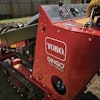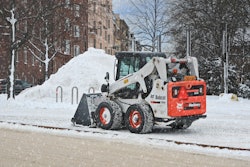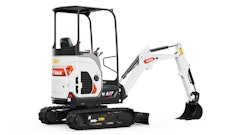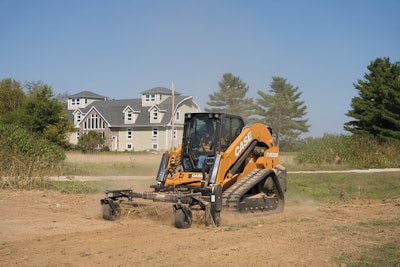
While there are several criteria that determine the correct attachment for a particular skid steer or CTL, perhaps one of the least understood is hydraulic compatibility. In a recent webinar, product experts at Case Construction Equipment simplified the selection process by educating attendees on the basic hydraulic system considerations.
The process really begins with the hydraulic flow and pressure ratings on both the machine and attachments. Understanding the relationships between flow and pressure is critical when matching attachments to a skid steer or CTL. Start by looking at the fundamentals. “Flow is going to be the speed of the attachment under no restriction,” explains Ted Polzer, director of product and customer support, Case Construction Equipment. If an attachment lists a 30-gpm maximum flow, that is at no pressure or resistance to that flow. “As soon as we start to resist flow, that’s when we start to build pressure. It’s really important to understand what your maximum constraints are for the attachment on the flow and that pressure.”
If you chart flow versus pressure, there is a point where flow and pressure cross to create the most productive setting for a specific attachment. Consider a cold planer. “If you are crowding it too hard and you are running at 3,000 psi, for the sake of discussion, you are going to start generating heat, and you are not helping the productivity of the machine,” says Polzer. “You could be more productive by actually backing off a little bit and reducing some of that resistance to the flow. Your attachment will probably run more consistent with its speed, in addition you’re not fighting that additional heat that is being built in the system. So it’s extremely important to understand exactly what your machine will do and what your attachments are capable of accepting.” This is where a pressure gauge on the attachment can prove beneficial.
Pressure Gauges Can Eliminate Guesswork
“Pressure gives you an idea of how much work you can do,” says Polzer. “One of the training aides that we have used is we simply put a pressure gauge in an area that’s visible to the operator. We mark that and say you’re more productive at this pressure.” This helps eliminate operator concerns. “It is a very inexpensive way to understand exactly where you can be (when operating) and it will drive a lot of consistency with your operators if they are watching that target.” It is worth noting that some of today’s attachments come with a pressure gauge mounted on the attachment clearly visible to the operator.”
Hydraulic horsepower can serve as a good indictor to match machines and attachments in terms of hydraulic system compatibility. This can be calculated by the simple equation hydraulic horsepower = [pressure (psi) *flow (gpm)]/1714. Hydraulic horsepower is good to know because it is essentially telling you what your machine is capable of doing, what your attachment can accept and what kind of productivity to expect. “What’s important about that is many hydraulic attachments are also rated by their hydraulic horsepower.” This is starting to be more common with the newer attachments.
Hydraulic horsepower can be used as a gauge to judge proper sizing the between the attachment and the machine. “It doesn’t make a lot of sense to take an attachment that can only accept 40 hydraulic horsepower and mate it to a 90 hydraulic horsepower machine, or vice versa,” says Polzer. “It is always important to have those matched.” If the hydraulic horsepower is not published on your machine or attachment, it can be quickly calculated using the hydraulic horsepower equation. You simply need to know the flow and pressure ratings, “That way, moving forward, you know exactly what the right attachments for your machine are.”
Upsizing attachments is not recommended. “A really common misconception is if the maximum hydraulic horsepower is 40, and if a buy an attachment that’s capable of 60, you can grow into it,” notes Polzer. “I’ll have it longer. It will work on more machines. It will function, however, you need to remember when we build an attachment for high pressure, such as enhanced high flow, we’re typically looking at a different type of drive motor inside of that attachment. Maybe it is an axial piston motor versus a gerotor motor on a low flow, low pressure type of attachment. These are really important points that you really need to understand because while that attachment might couple up to other machines, it’s not going to be as productive.” Make sure you really understand the productivity of the paired attachment and carrier.
Understand How Settings Impact Performance
On some premium machines the machine’s flow can be tailored to the application and attachment. “A lot of our newer machines have an adjustable flow rate from inside the cab,” notes Polzer. While this is beneficial for optimum performance, it can also create confusion as to what flow should be used with each attachment. “One customer I visited had a great idea,” notes Polzer. “They mad a laminated card that told the operators that if they run this attachment, set the flow to this. “It made for more productivity out of their attachments. It also reduced the risk of having the wrong attachment.”
Accidently mating a low flow attachment to a large hydraulic horsepower machine with a high-pressure system and not properly dialing in the hydraulic flow is a recipe for failure.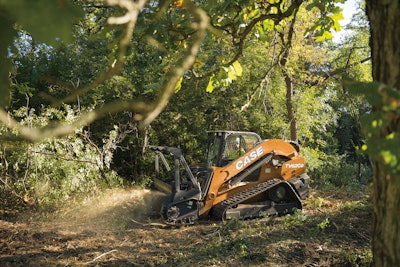 Examples of attachments that use an enhanced high flow system would include large cold planers, large mulching heads and rock saws where you might be able to clear brush and small trees with that mulcher more efficiently than you could with a regular high flow system.Case Construction Equipment
Examples of attachments that use an enhanced high flow system would include large cold planers, large mulching heads and rock saws where you might be able to clear brush and small trees with that mulcher more efficiently than you could with a regular high flow system.Case Construction Equipment
Three Common Hydraulic System Choices
Skid-steers and CTLs come from the factory with different levels of auxiliary hydraulic capability. “We offer three core systems – standard, high flow and enhanced high flow,” says George MacIntyre, product marketing manager, Case Construction Equipment. “The most common system is the standard flow auxiliary hydraulic package. Although flow rates differ by manufacturer and model, the flow rate of the standard flow system ranges from 17 to 24 gpm. Standard flow auxiliary hydraulics are included in all machines from the factory and operate on the same pressure that the machine’s main hydraulics operate on, which is approximately 3,000 to 3,500 psi. The standard flow system power many of the most common hydraulic attachments on the market, such as the four-in-one buckets, hydraulic hammers, augers, trenchers and grapples.”
High flow systems further increase the machine’s versatility and productivity. “As with standard flow, it operates on the same pressures as the main hydraulic circuits,” says MacIntyre. “The flow rate, however, ranges from 30 to 42 gpm.” Production-type attachments that may require a high flow rate to perform as specified include cold planers, many snowblowers, rock saws, mulching heads and chipper shredders.
Stepping up the performance chain, high flow systems can be combined with high pressure. “Enhanced high flow hydraulics have flow rates that are similar a skid steer with a high flow package, yet it operates at 4,100 psi,” notes MacIntyre. “Examples of attachments that use an enhanced high flow system would include large cold planers, large mulching heads and rock saws where you might be able to clear brush and small trees with that mulcher more efficiently than you could with a regular high flow system.
The industry is marching toward the more performance orientated options. “If you look at what has happened in the industry in the last 10 years, we’re seeing a lot more of the customers wanting to have machines that have the higher flow rating,” says MacIntyre. “Our take rates out of the factory are increasing quite a bit going to the high flow and enhanced high flow systems.”
With supply shortages, the high flow machines expand your choice of rental attachments. “If you’re a customer that doesn’t own a lot of attachments and you are heavily renting attachments, having a machine equipped with different high flow auxiliaries from the factory gives you the capability to get attachments easier rather than having to pick and choose exactly which ones fit,” says Polzer. “It gives you that little bit of flexibility.”
High flow capable machines offer more flexibility. “If you look at the system itself, you’re able to actually switch between the different modes,” explains MacIntyre. “Even if you have enhanced high flow, it doesn’t mean you need to run an enhanced high flow attachment with that. There’ a switch in the cab that allows you to switch between regular high flow and the enhanced high flow.”
Ensuring the machine is set up with the proper secondary circuit can also add flexibility. That secondary circuit is used for when you have an additional function that can not be handled by the primary circuit. Those applications include things like a side shift function on a cold planer or a stump grinder, changing the direction of a snow thrower chute or a tree spade where you need to deploy downriggers. It is important to note that today’s attachments often have a flow diverter valve built into the valve, eliminating the need for a secondary circuit.


